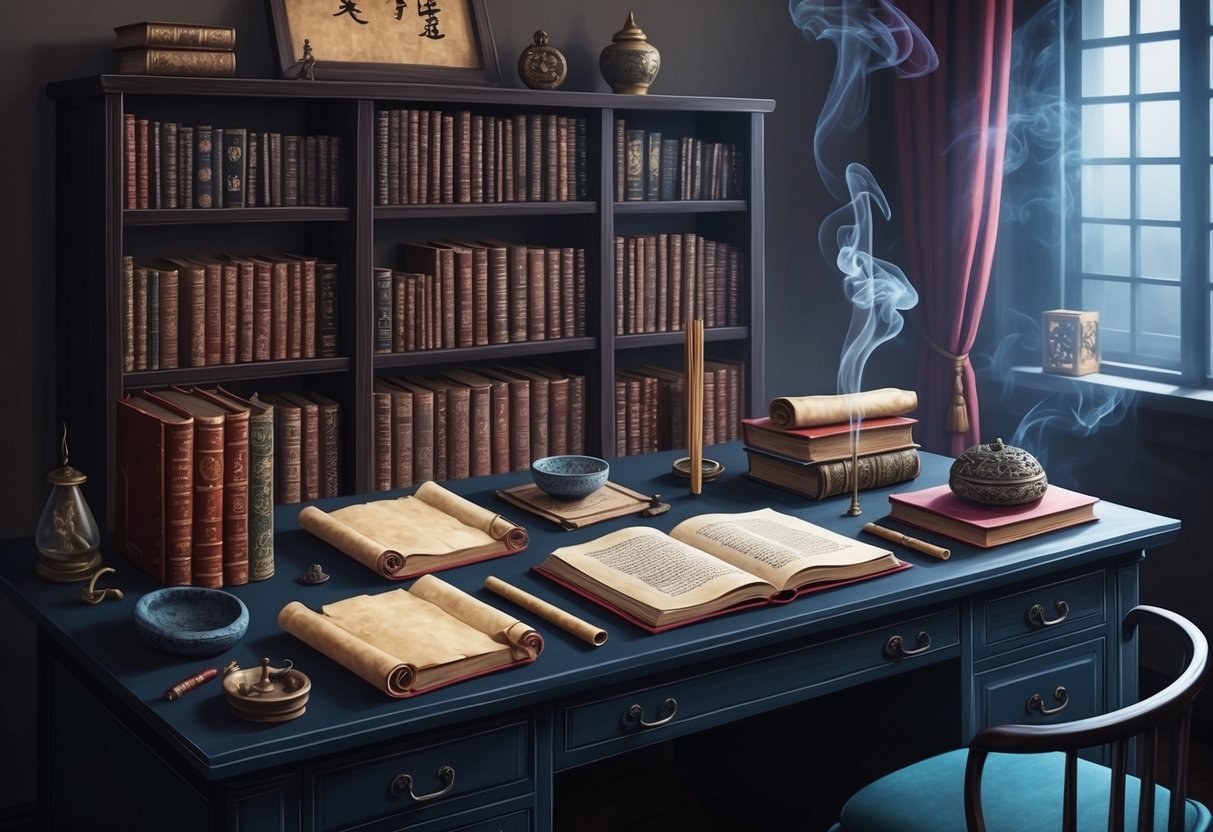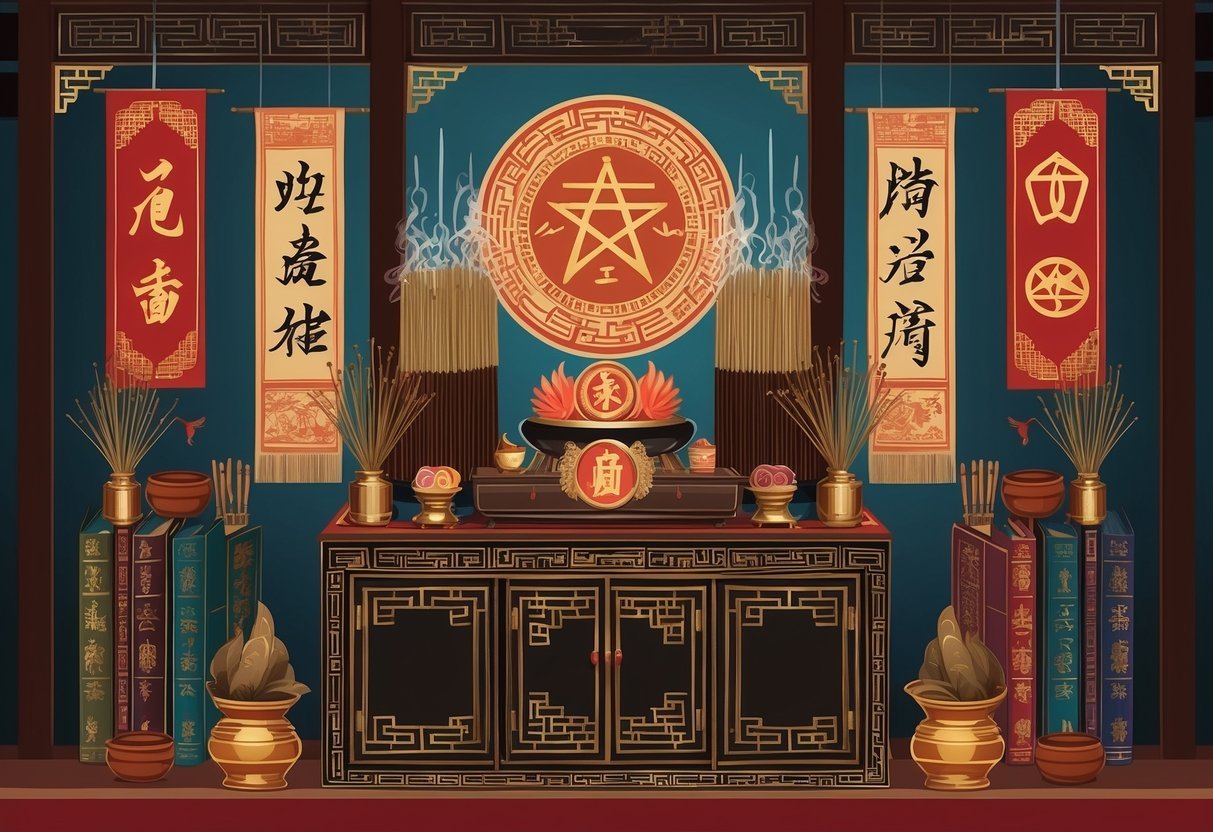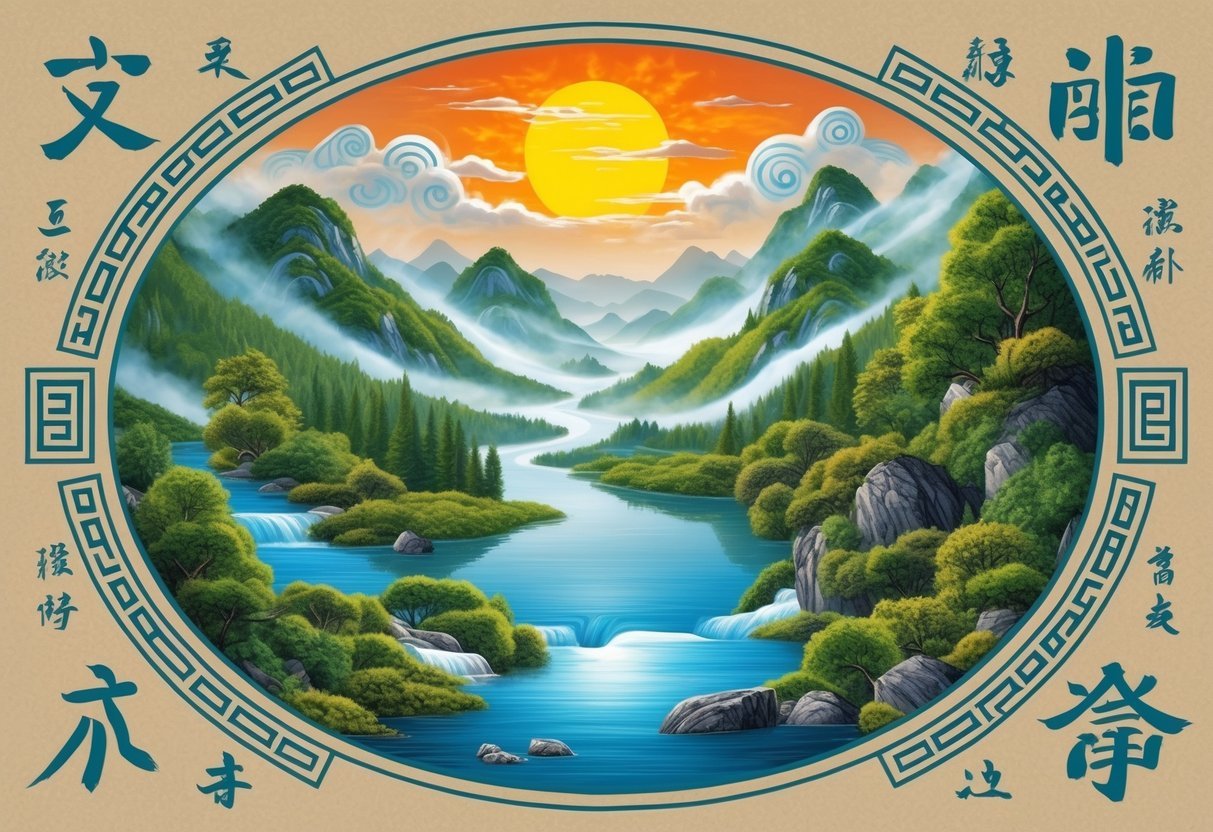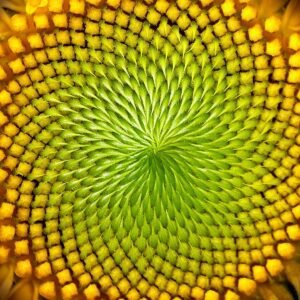Exploring Chinese occult books offers a unique insight into a world where mysticism and tradition intertwine. Rooted in ancient philosophies, these texts encompass a range of practices including divination and astrology. The influence of these traditions extends beyond religion, offering guidance and wisdom through centuries.

Historical texts such as the I Ching, also known as the Book of Changes, have played a fundamental role in shaping the understanding of Chinese mysticism. These books reveal a sophisticated system of symbols and interpretations used in divinatory practices. Chinese occultism often integrates the philosophy of the Five Elements, which serves as a foundational framework for understanding the universe.
In modern times, the interpretation of these texts continues to evolve, blending ancient wisdom with contemporary perspectives. As readers delve deeper into the themes and symbols present in these works, they uncover the enduring legacy of Chinese occultism.
Key Takeaways
- Chinese occult books blend mysticism with traditional philosophy.
- They are rooted in historical texts and divinatory practices.
- Modern interpretations continue to evolve from these ancient teachings.
Historical Context of Chinese Occultism
Chinese occultism has deep historical roots, intertwining with ancient practices and philosophical beliefs. Ancient China saw the emergence of hidden knowledge, while Taoism profoundly shaped mystical ideologies.
Origins of Occult Practices in Ancient China
In ancient China, the origins of occult practices trace back to shamanistic traditions, which relied heavily on rituals to communicate with the spirit world. Divination methods, such as the Yih system, were foundational. Techniques like casting lots and interpreting natural omens played key roles.
The Zhou dynasty contributed significantly. Figures like Wen Wang, known as the “scholar-king,” documented occult activities in Chinese history. His contributions established a framework where mystical practices were not only religious but also state activities. Wen Wang, also referred to in the context of occultism, emphasized using oracles to guide decisions, bridging the gap between cosmic phenomena and earthly events.
This era laid the groundwork for subsequent developments, integrating celestial observations into comprehensive systems of hidden knowledge.
Influence of Taoism on Occult Beliefs
Taoism has had a pronounced influence on Chinese occult beliefs. Fundamental Taoist principles, such as harmony with nature and the flowing of the Tao, permeated mystical doctrines. The blending of occultism with Taoist philosophy resulted in a body of knowledge focused on balance and spiritual alignment.
Taoist sorcery reflected these principles by employing rituals intended to harness cosmic energies. Taoist metaphysical beliefs involved understanding yin and yang dynamics, which are seen in practices meant to heal and protect. Notably, Taoist practices blended seamlessly with the syncretic aspects of Chinese occultism, as seen in the lecture series that explores these interactions.
This dynamic integration of ideologies created a rich tapestry of mystical thought, shaping the trajectory of Chinese occult traditions.
Chinese Occult Practices and Their Purpose

Chinese occult practices encompass a wide array of rituals and meditation techniques aimed at achieving spiritual growth, healing, and enlightenment. These practices, often integrating elements from both Taoism and Buddhism, involve elaborate ceremonies and meditative exercises that serve specific spiritual and practical purposes.
Rituals and Ceremonies
Rituals form an essential part of Chinese occult practices. They typically involve a series of structured activities designed to invoke spiritual energies or deities for protection, healing, or to gain insight. For instance, talismans play a significant role in such ceremonies, believed to channel protective forces. The use of incense, chanting, and specific hand gestures often accompany these rituals to enhance their efficacy.
Ceremonies may also focus on aligning the practitioner’s energies with cosmic forces, such as during festivals or personal milestones. This alignment is believed to enhance well-being and bring about desired changes in one’s life. Many of these practices have historical roots, dating back to ancient China, with evidence found in manuscripts that document ceremonial protocols and their intended outcomes.
Role of Meditation and Enlightenment
Meditation is central to Chinese occult practices, emphasizing the cultivation of inner peace and spiritual awareness. Techniques often vary, ranging from seated meditation and breath control to visualization practices. These methods aim to transcend the material world, opening pathways to enlightenment and a deeper connection with the universe. Taoist and Buddhist doctrines frequently influence these meditative practices, each offering distinct approaches and philosophies.
Enlightenment in this context is not merely an abstract concept but a transformative experience that affects one’s perception of self and reality. Practitioners believe that achieving enlightenment can lead to a harmonious existence, free from worldly distractions and suffering. Through disciplined meditation, individuals seek spiritual insights that can guide them towards a more profound understanding of life and their place within it.
The Five Elements and Occult Symbolism

The five elements—water, fire, wood, metal, and earth—play a crucial role in linking Chinese thought with occult practices. Each element corresponds to cosmic bodies, planetary influences, and natural phenomena, reflecting deep connections with mystical symbolism and ancient philosophies.
Interpreting the Chinese Elements in Occult Terms
In Chinese occultism, the five elements are not just physical substances but also energetic forces that impact the world. They correlate with the planets: water with Mercury, fire with Mars, wood with Jupiter, metal with Venus, and earth with Saturn. These associations highlight their cosmic influence, reflecting their fundamental role in the universe’s structure.
Interpreting these elements in occult practices involves understanding their dynamic interactions. The philosophy utilizes these interactions to balance energies and influence outcomes. For example, the elements are integral to feng shui, which arranges spatial elements to optimize harmony and energy flow. This integration showcases how the five elements serve as a foundation in practices such as astrology and magic, forming symbolic language that enriches their mystical significance.
Mysticism and Divination in Chinese Occult

Chinese occult traditions intertwine deeply with the practices of mysticism and divination, reflecting a complex blend of cultural and spiritual beliefs. These practices employ various methods and tools to interpret omens and uncover hidden truths.
Methods and Practices of Divination
In Chinese culture, divination is a significant practice that utilizes numerous methods to seek insight and guidance. One of the oldest methods involves oracle bones, a practice dating back to the Shang Dynasty, where questions were inscribed on bones and interpreted through the resulting cracks.
Another prominent practice is the use of the I Ching, or Book of Changes, which offers guidance through hexagrams generated by casting coins or yarrow sticks. This ancient text provides philosophical insights and advice based on patterns formed by the castings.
Tea leaf reading, although not as traditional as the I Ching, has also found its place among Chinese divinatory practices. Practitioners interpret patterns formed by tea leaves left at the bottom of a teacup to gain insights.
Feng Shui is another essential aspect of Chinese divination, focusing on the harmony between individuals and their environment. By calculating the auspicious orientation of structures, practitioners aim to optimize the flow of Qi for prosperity and health. Each method underscores the rich tapestry of mystical and divinatory practices in the Chinese occult tradition.
Talismans and Incantations

Talismans and incantations serve significant roles in Chinese mystical practices, interweaving symbols and spoken words to harness spiritual and protective influences. These practices focus on creating objects like talismans while using spoken words or incantations for magical effects.
Creating and Using Talismans
Talismans, often known as Fu or Fulu, are vital in traditional Chinese mysticism. They are crafted on paper or wood, inscribed with symbols and characters believed to possess magical properties. Experts engrave these symbols with precision, often while invoking spiritual powers.
Practitioners hold that talismans can protect individuals from harm, invite good fortune, or achieve specific wishes. The process of creating talismans involves precise calculation of astrology and numerology, ensuring that the talisman aligns with cosmic energies. Usage often requires the talisman to be worn or placed in a specific area, believed to activate its power.
Many believe that Chinese talismans concentrate the sorcerer’s focused intention and psychic abilities. These objects are not just seen as symbols but as vessels that hold significant power through sacred inscription.
The Power of Incantations and Spells
Incantations and spells are core components of Chinese Taoist practices, using verbal expressions to channel and unlock mystical energies. The incantations combine specific words and tonal patterns that are key to impacting spiritual realms and enhancing rituals.
Spoken incantations are often chanted or whispered during ceremonial practices. They serve various purposes, such as invoking spirits, banishing negative forces, or blessing individuals with prosperity. The effectiveness is believed to depend on the practitioner’s skill and the purity of intention.
Historical texts and manuals, such as the Daoist Magical Talismans, highlight the significance of these vocalized spells. They are intrinsic to the rituals and serve as bridges between the physical and spiritual worlds. The knowledge of these incantations has been preserved in scripts, guiding both novices and seasoned practitioners.
The Practice of Chinese Witchcraft
Chinese witchcraft, deeply rooted in the nation’s history, intertwines with ancient religious and cultural beliefs. It encompasses diverse practices and rituals, often aimed at harnessing supernatural forces for personal or communal benefit.
Witchcraft Within Chinese Occult Traditions
Witchcraft in China has a rich history that is closely associated with shamanistic traditions and ceremonial practices. It involves Wuism, a shamanic religious tradition that plays a significant role in Chinese spiritual life. Practitioners, known as shamans or “wu,” were believed to communicate with spirits and deities to offer guidance or protection.
These traditions often employed rituals and spells intended to heal, invoke favor, or ward off evil influences. During the Song Dynasty, Thunder Rites or Thunder Magic gained popularity, symbolizing the integration of esoteric practices into witchcraft. Additionally, historical texts reflect how witchcraft influenced societal events, such as ancient ceremonies to control floods, which sometimes involved marrying a princess to the Yellow River God to appease supernatural entities.
Modern Perspectives on Chinese Occult
Modern Chinese occult practices have evolved yet continue to encompass elements of traditional belief systems such as Taoism. These practices often blend ancient customs with contemporary interpretations, reflecting both historical roots and present-day dynamics.
Contemporary Practice and Beliefs
In contemporary China, occultism manifests through a fusion of traditional Taoist rituals and modern adaptations. Many individuals engage with talismans, astrology, and divination as methods to seek guidance and fortune. These practices offer an intriguing blend of cultural heritage and modern-day belief systems, indicating a persistent interest in spiritual and esoteric knowledge.
The role of occult arts in current healthcare and wellness markets is also notable. Practices like feng shui and traditional medicine have found their place in modern health philosophy, merging metaphysical concepts with practical health benefits. This indicates an enduring respect for and reliance on the spiritual dimensions of existence in daily life.
Frequently Asked Questions
Chinese occult traditions are deeply intertwined with philosophy, medicine, and spiritual practices. These traditions influence various aspects of life, guiding practices in divination and Feng Shui while anchored in key historical texts.
What are the key principles of Chinese occult philosophy?
Chinese occult philosophy emphasizes harmony with nature and the universe. It often integrates elements of Taoism and Buddhism. The balance of yin and yang and the Wu Xing, or Five Elements, are central concepts that guide understanding and application of occult practices.
How does Chinese occultism intersect with traditional Chinese medicine?
Chinese occultism is closely related to traditional Chinese medicine through the concept of Qi, or life force. Practices such as acupuncture and herbal remedies are believed to balance Qi within the body, reflecting the harmony sought in Chinese spiritual and occult traditions.
Can you identify major historical texts on Chinese occult practices?
Key historical texts include the I Ching, also known as the Book of Changes, which serves as a divination manual. The Daozang is a comprehensive collection of Taoist texts, many of which inform occult practices by exploring mystical and metaphysical aspects of the universe.
How do Feng Shui principles relate to the broader field of Chinese occultism?
Feng Shui principles focus on optimizing the flow of energy in environments. These principles are rooted in the broader field of Chinese occultism, applying Taoist ideas about balance and harmony to architecture, urban planning, and interior design, ensuring that spaces align with cosmic energies.
What role does divination play in Chinese occult traditions?
Divination is a significant aspect of Chinese occult traditions, providing insight and guidance. Methods such as the I Ching and oracle bone script have been used historically to interpret signs from the natural world, seeking knowledge about future events or solutions to problems.
In what ways has Chinese occult thought influenced contemporary spiritual practices?
Chinese occult thought has significantly influenced contemporary spiritual practices worldwide. Concepts such as Qi, yin and yang, and the Five Elements have been integrated into various holistic and alternative health practices. Additionally, Feng Shui and Tai Chi have gained popularity for promoting well-being and balance.


